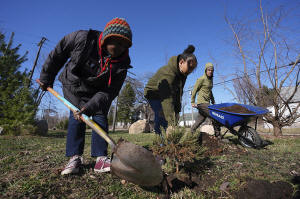A sequoia forest in Detroit? Plantings to improve air quality and mark
Earth Day
[April 22, 2025]
By COREY WILLIAMS
DETROIT (AP) — Arborists are turning vacant land on Detroit's eastside
into a small urban forest, not of elms, oaks and red maples indigenous
to the city but giant sequoias, the world's largest trees that can live
for thousands of years.
The project on four lots will not only replace long-standing blight with
majestic trees, but could also improve air quality and help preserve the
trees that are native to California’s Sierra Nevada, where they are
threatened by ever-hotter wildfires.
Detroit is the pilot city for the Giant Sequoia Filter Forest. The
nonprofit Archangel Ancient Tree Archive is donating dozens of sequoia
saplings that will be planted by staff and volunteers from Arboretum
Detroit, another nonprofit, to mark Earth Day on April 22.
Co-founder David Milarch says Archangel also plans to plant sequoias in
Los Angeles, Oakland, California, and London.
What are giant sequoias?
The massive conifers can grow to more than 300 feet (90 meters) tall
with a more than 30-foot (9-meter) circumference at the base. They can
live for more than 3,000 years.
“Here’s a tree that is bigger than your house when it’s mature, taller
than your buildings, and lives longer than you can comprehend,” said
Andrew “Birch” Kemp, Arboretum Detroit's executive director.
The sequoias will eventually provide a full canopy that protects
everything beneath, he said.

“It may be sad to call these .5- and 1-acre treescapes forests,” Kemp
said. “We are expanding on this and shading our neighborhood in the only
way possible, planting lots of trees.”
Giant sequoias are resilient against disease and insects, and are
usually well-adapted to fire. Thick bark protects their trunks and their
canopies tend to be too high for flames to reach. But climate change is
making the big trees more vulnerable to wildfires out West, Kemp said.
“The fires are getting so hot that its even threatening them,” he said.
Descendants of Stagg and Waterfall
Archangel, based in Copemish, Michigan, preserves the genetics of
old-growth trees for research and reforestation.
The sequoia saplings destined for Detroit are clones of two giants known
as Stagg — the world's fifth-largest tree — and Waterfall, of the Alder
Creek grove, about 150 miles (240 kilometers) north of Los Angeles.
In 2010, Archangel began gathering cones and climbers scaled high into
the trees to gather new-growth clippings from which they were able to
develop and grow saplings.
A decade later, a wildfire burned through the grove. Waterfall was
destroyed but Stagg survived. They will both live on in the Motor City.
Why Detroit?
Sequoias need space, and metropolitan Detroit has plenty of it.

[to top of second column]
|

Robyn Redding, from left, and Gianna Holliday plant a sequoia tree
seedling as Andrew "Birch" Kemp brings mulch in Detroit, Friday,
March 21, 2025. (AP Photo/Paul Sancya)

In the 1950s, 1.8 million people called Detroit home, but the city's
population has since shrunk to about one-third of that number. Tens
of thousands of homes were left empty and neglected.
While the city has demolished at least 24,000 vacant structures
since it emerged from bankruptcy in 2014, thousands of empty lots
remain. Kemp estimates that only about 10-15% of the original houses
remain in the neighborhood where the sequoias will grow.
“There’s not another urban area I know of that has the kind of
potential that we do to reforest," he said. “We could all live in
shady, fresh air beauty. It's like no reason we can’t be the
greenest city in the world.”
Within the last decade, 11 sequoias were planted on vacant lots
owned by Arboretum Detroit and nine others were planted on private
properties around the neighborhood. Each now reaches 12 to 15 feet
(3.6 to 4.5 meters) tall. Arboretum Detroit has another 200 in its
nursery. Kemp believes the trees will thrive in Detroit.
“They’re safer here ... we don’t have wildfires like (California).
The soil stays pretty moist, even in the summer,” he said. “They
like to have that winter irrigation, so when the snow melts they can
get a good drink.”
How will the sequoias impact Detroit?
Caring for the sequoias will fall to future generations, so Milarch
has instigated what he calls “tree school” to teach Detroit’s youth
how and why to look after the new trees.
“We empower our kids to teach them how to do this and give them the
materials and the way to do this themselves,” Milarch said. “They
take ownership. They grow them in the classrooms and plant them
around the schools. They know we’re in environmental trouble.”
Some of them may never have even walked in a forest, Kemp said.

“How can we expect children who have never seen a forest to care
about deforestation on the other side of the world?" Kemp said. "It
is our responsibility to offer them their birthright.”
City residents are exposed to extreme air pollution and have high
rates of asthma. The Detroit sequoias will grow near a heavily
industrial area, a former incinerator and two interstates, he said.
Kemp’s nonprofit has already planted about 650 trees — comprising
around 80 species — in some 40 lots in the area. But he believes the
sequoias will have the greatest impact.
“Because these trees grow so fast, so large and they’re evergreen
they’ll do amazing work filtering the air here,” Kemp said. “We live
in pretty much a pollution hot spot. We’re trying to combat that.
We’re trying to breathe clean air. We’re trying to create shade.
We’re trying to soak up the stormwater, and I think sequoias — among
all the trees we plant — may be the strongest, best candidates for
that.”
All contents © copyright 2025 Associated Press. All rights reserved |